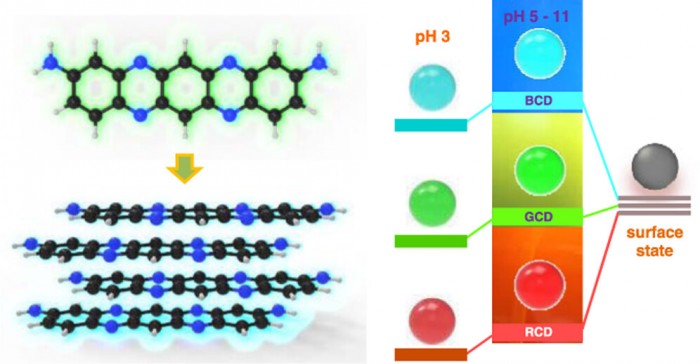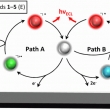댓글 쓰기 권한이 없습니다. 로그인 하시겠습니까?
Fluorophore-Dependent Optical Properties of Multicolor Carbon Dots for Bioimaging and Optoelectronic Devices
| Journal | ACS Applied Nano Materials |
|---|---|
| Author | Hyeong Seop Shim, Jeongyun Choi, Seonghyun Jeong, Sangwon Nam, Joohoon Kim*, and Jae Kyu Song* |
| Citation | ACS Appl. Nano Mater. 2023, 6, 18, 17120?17129 |
| DOI | https://doi.org/10.1021/acsanm.3c03328 |

To achieve the high tunability and quantum yield of carbon dots (CDs) suitable for applications to bioimaging and optoelectronic devices, optical features are systematically investigated in three types of CDs. Phenylenediamine isomers are employed to develop the CDs of blue, green, and red. Despite the comparable chemical structures and functional groups, the predominant optical transitions are distinct in the three CDs, which is mainly attributed to the configurations of fluorophores in aggregated structures. Another type of optical transition is also observed, whose energies are similar in the three CDs, implying the involvement of surface states. The first-principles calculations indicate that the functional groups change the electronic structures and transition energies, suggesting that oxidation-related states are responsible for the surface states. In a wide range of pH, the optical transitions remain stable, although the protonated chromophores result in shifted transitions in highly acidic conditions. The protonation of the nitrogen moiety influences the electronic structures, while the protonated position controls the relaxation processes. These findings offer strategies to improve the multicolor CDs with a green chemistry approach, which are suitable for applications to bioimaging and optoelectronic devices as alternatives to metal-based semiconductor quantum dots.
-
Read More

Fluorophore-Dependent Optical Properties of Multicolor Carbon Dots for Bioimaging and Optoelectronic Devices
Category2023 AuthorHyeong Seop Shim, Jeongyun Choi, Seonghyun Jeong, Sangwon Nam, Joohoon Kim*, and Jae Kyu Song* JournalACS Applied Nano Materials CitationACS Appl. Nano Mater. 2023, 6, 18, 17120?17129
-
Read More

Galvanic Bipolar Electrode Arrays with Self-Driven Optical Readouts
Category2023 AuthorHyein Lee, Jiwoo Kim, Misol Hwang, and Joohoon Kim JournalACS Sensors CitationACS Sens. 2023, 8, 11, 4374?4383
-
Read More

Electrochemiluminescence of dimethylaminonaphthalene-oxazaborine donor?acceptor luminophores
Category2023 AuthorKyoung-Rok Kim , Jiwoo Kim , Jinrok Oh , Joohoon Kim and Jong-In Hong JournalChemical Communications CitationChem. Commun., 2023, 59, 13058-13061
-
Read More

In Situ Confocal Fluorescence Lifetime Imaging of Nanopore Electrode Arrays with Redox Active Fluorogenic Amplex Red
Category2023 AuthorHyein Lee, Kyoungsoo Kim, Chung Mu Kang, Aeri Choo, Donghoon Han, and Joohoon Kim JournalAnalytical Chemistry CitationAnal. Chem. 2023, 95, 2, 1038?1046
Designed by sketchbooks.co.kr / sketchbook5 board skin
Sketchbook5, 스케치북5
Sketchbook5, 스케치북5
Sketchbook5, 스케치북5
Sketchbook5, 스케치북5
.png)


 Galvanic Bipolar Electrode Arrays with Self-Driven...
Galvanic Bipolar Electrode Arrays with Self-Driven...